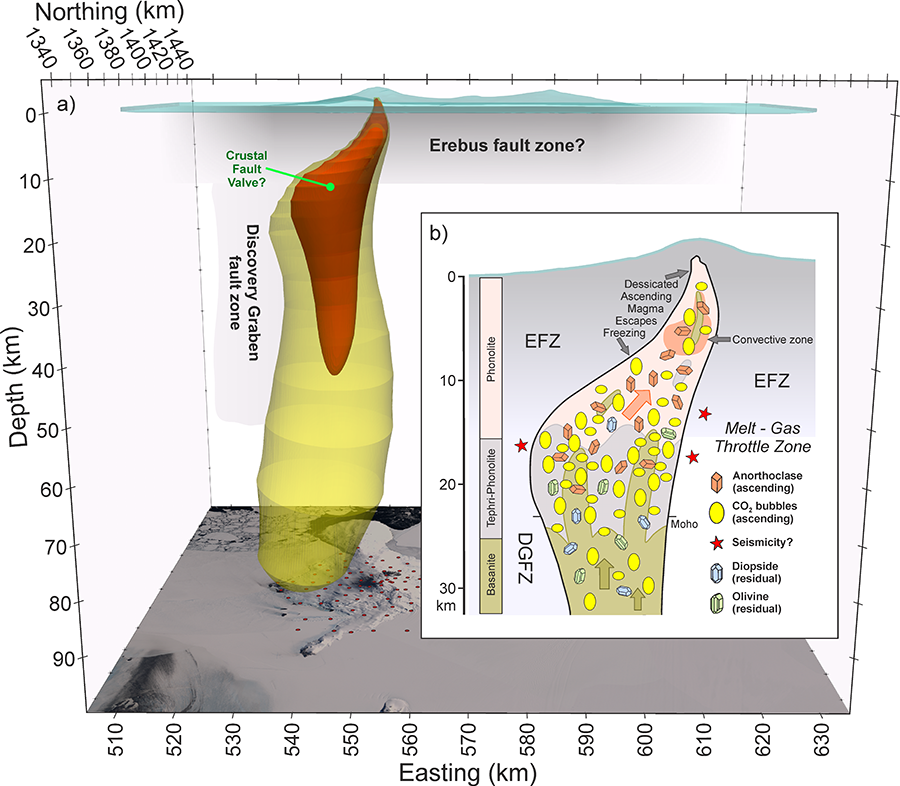Follow the magma: Scientists map plumbing beneath Mt. Erebus for the first timeNew results help explain the Antarctic volcano's strange eruptions and why its lava lake has persisted for so longPosted October 04, 2022
It is with great sadness we report that on Monday August 22, 2022 Dr. Philip E. Wannamaker, quoted as part of this article, passed away in Salt Lake City, Utah. Dr. Wannamaker was active in basic and applied geophysical research and the U.S. Antarctic Program will greatly miss his leadership, his research, and his humor. A 20-kilometer-wide tube of melted rock feeds the lava lake at Mt. Erebus, according to new research that illustrates the plumbing below Earth's southernmost active volcano for the first time. Scientists recently published the first three-dimensional schematics of Erebus's magma chamber, the conduit that brings melted rock from Earth's mantle up to the surface. The images show a nearly vertical tube of magma that extends about 100 kilometers down into the mantle. About 15 kilometers below the volcano, the tube narrows and turns slightly eastward, creating a structure geologists call a fault valve. The fault valve acts like a nozzle that controls the flow of magma and gas upward into Erebus's open lava lake. The nozzle pushes small amounts of magma and carbon dioxide to the surface in pulses, rather than allowing them to flow continuously. This process helps keep the magma hot, dry and runny, which may explain why Erebus has small, gassy eruptions and how its lava lake has persisted for decades. The lava lake at Erebus is one of only a handful on Earth, so any insight into its workings helps scientists better understand how these unusual features form. Studying Erebus's plumbing also helps geologists understand how rare chemical elements may make it from Earth's mantle to its surface, according to Phil Wannamaker, a geologist at the University of Utah and co-author of the study. “Rift systems such as Mount Erebus have, in some geological intervals, emitted climate-forcing levels of carbon dioxide,” Wannamaker said. “Understanding the controls and geometry of magma movements might also improve regional exploration models for rare elements that we need for everyday life.” Getting a peek behind the curtain
Graphic by Hill et al, Nature Communications, 2022, DOI 10.1038/s41467-022-30627-7.
A schematic of the plumbing beneath Mt. Erebus and the conduit that brings hot magma to Earth's surface.
Volcanologists have been studying Mt. Erebus for decades. It's an unusual volcano and a unique natural laboratory because of the football field-sized lava lake in its summit crater. It's also been active for over a million years and carries more carbon dioxide with its magma than many other volcanoes. “Erebus is an interesting volcano independent of it being in Antarctica,” Wannamaker said. “It's one of the purest carbon dioxide-dominated volcanoes in the world.” Volcanologists often try to map the plumbing system below volcanoes to see what pathways molten rock takes to get to the surface. Usually, they use seismic waves generated by earthquakes and other phenomena to create a kind of CT scan of the volcano's plumbing. But this is difficult at Erebus because there haven't been enough earthquakes nearby to generate a good enough picture of its underbelly. In 2014, Wannamaker, along with colleague Graham Hill and others, set out to map Erebus's plumbing using a different method. Over the course of three Antarctic summer seasons, the researchers used magnetotelluric data acquired with helicopter support to visualize the rock structures below Ross Island, where Erebus is located. Their method uses naturally occurring electromagnetic waves to image the rocks of Earth's crust and mantle based on how well they conduct electricity. This allows them to differentiate between solid rock and molten rock (molten rock conducts electricity, whereas solid rock doesn't). So, they can see what pathways magma takes from where it's created in Earth's mantle as it travels to the crust and eventually up to the surface. A toothpaste tube of magmaThe results show a straight, nearly vertical tube of magma below Erebus that is 20 kilometers wide and extends about 100 kilometers below Earth's surface. This means molten rock flows directly from the mantle to the lava lake, although the magma goes through chemical changes as it ascends. “The two things we really saw were a fault valve that is controlling the episodic breakthrough of magma toward the surface, and second, we're able to follow the magma continuously and completely right to the lava lake,” Wannamaker said. The magma feeding Erebus is rich in carbon dioxide, which absorbs water out of the molten rock, keeping it hot and dry. This prevents the magma from becoming too viscous and stalling as it ascends through Earth's crust. The amount of carbon dioxide in the magma coupled with Erebus's unique plumbing help explain why the volcano has small, periodic eruptions and why its lava lake stays hot and liquid. The superhot, liquid magma and gas travel straight upward through the long tube then squeeze through the fault valve in pulses. This gives the lava lake regular injections of molten rock and ensures the volcano has frequent, mild eruptions rather than fewer, more explosive outbursts like water-rich volcanoes do. “There are these large pre-existing structures that control the flow and evolution of the magma; it's not just sitting there, independent of any pre-existing constraints,” Wannamaker said. This research is supported by the National Science Foundation, which manages the U.S. Antarctic Program. NSF-funded research in this story: Philip Wannamaker, University of Utah, awards 1443522; Philip Kyle, New Mexico Institute of Mining and Technology, awards 1141534 and 1644234. |
"News about the USAP, the Ice, and the People"



For USAP Participants |
For The Public |
For Researchers and EducatorsContact UsU.S. National Science FoundationOffice of Polar Programs Geosciences Directorate 2415 Eisenhower Avenue, Suite W7100 Alexandria, VA 22314 Sign up for the NSF Office of Polar Programs newsletter and events. Feedback Form |


